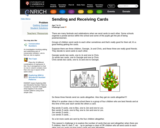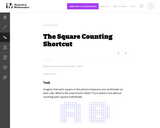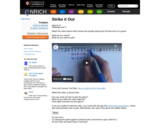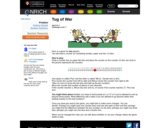
This three-act math task utilizes videos and questioning to help students explore addition and subtraction within 100.
- Subject:
- Mathematics
- Material Type:
- Activity/Lab
- Provider:
- GFletchy
- Author:
- Graham Fletcher
- Date Added:
- 10/25/2022

This three-act math task utilizes videos and questioning to help students explore addition and subtraction within 100.

This three-act math task utilizes videos and questioning to help students explore addition and subtraction within 1000.

In this challenging instructional task students relate addition and subtraction problems to money and to situations and goals related to saving money.

This word problem may be used for instructional or assessment purposes, depending on where students are in their understanding of addition and how the teacher supports them.

This open-ended investigation provides an opportunity for students to develop problem solving skills and explore patterns while applying number skills. Posed in the context of friends sending each other cards, it asks students to find how many cards are sent based on the number of friends, and to look for patterns that emerge in the results. The Teachers' Resources page offers rationale, suggestions for implementation, discussion questions, and ideas for extension and support. Be sure to check out the Solutions page to appreciate the potential range of student thinking.

The purpose of this task is for students to select 2 numbers from a set that sum to 5 (or any other number).

Students gain experience and practice with three types of word problems using the "Take From" context: result unknown, change unknown, and start unknown.

This activity provides students with an opportunity to recognize arithmetic sequences and at the same time reinforces identifying multiples. The interactivity displays five numbers and the student must discover the times table pattern and the numerical shift. On Levels 1 and 2, the first five numbers in the sequence are given and on Levels 3 and 4, the numbers given could be any five numbers in the sequence. The Teachers' Notes page offers rationale, suggestions for implementation, discussion questions, ideas for extension and support.

This three-act math task utilizes videos and questioning to help students explore addition and subtraction within 100.

This is a rectangle subdivision task; ideally instead of counting each square. students should break the letters into rectangles, multiply to find the areas, and add up the areas. However, students should not be discouraged from using individual counting to start if they are stuck. Often students will get tired of counting and devise the shortcut method themselves.

This game for two players provides students with practice in whole number addition and subtraction while developing strategic thinking. It is played on paper on a 0-20 number line. Player 1 crosses off two numbers and circles either their sum or difference. In each successive turn players cross off the last circled number and one of their choice, and then circle the sum or difference. The player who makes the last possible move wins. The game also may be played co-operatively. The Teachers' Notes page offers suggestions for introducing the game, discussion questions, and extension ideas.

This lesson plan is designed to provide a resourch for teachers who have students needing extra support with subtraction and regrouping through the place value chart up to 1,000. It primarily targets using base ten blocks to help students visualize and manipulate regrouping.

In this version of a Sumo wrestling bout, players use mathematical skills to move their opponent's counter beyond the track and "out of the ring." Learners reveal playing cards and the player with the large value card pushes their counter a number of spaces equal to the difference between the two card values multiplied by the lower of the two card values. Learners can also explore what happens when a zero card is added to the mix.

Early childhood, between the ages of 2-8, is an important period for developing math skills. From the first years of life, your child is learning math and developing interest in the subject through everyday routines and play. Your support for the development of math knowledge and skills will help prepare your child for future success in school and life. Check out this infographic title, Supporting Your Child in Developing Math Skills for Future Success, to learn more about how early math success opens doors for future success in college and careers.
These family and caregiver resources and activities, organized by math topics such as counting or shapes, include research-based and easy-to-follow steps to help you support your child’s math skills during a typical day.

This task presents an incomplete problem and asks students to choose numbers to subtract (subtrahends) so that the resulting problem requires different types of regrouping. This way students have to recognize the pattern and not just follow a memorized algorithm--in other words, they have to think about what happens in the subtraction process when we regroup. This task is appropriate to use after students have learned the standard US algorithm.

This web page provides instructions for a game that develops number sense, basic addition and subtraction skills, and strategic thinking. Beginning with 10 Cuisenaire rods, one of each length from 1 (white) and 10 (orange), two players take turns adding one rod at a time to a train until it reaches a previously agreed-on length between 11 and 55. The player who puts down the last rod to complete the goal length is the winner. The game can be played with real rods, with the Flash applet provided, or with numbers on paper.

This Flash-based game of chance helps children learn about the relationship between the positive and negative integers. Two players, one Positive, moving left to right, and one Negative, moving right to left, take turns rolling and adding two dice and moving a counter in their respective directions on the number line, with the goal of reaching their end of the number line (13 or -13). The game can be played with the applet or on paper (printable pdf included). A variation involving the choice of adding, subtracting, multiplying or dividing the two dice introduces strategic thinking. The Teacher' Notes page suggests strategies for introducing the game, questions to facilitate students' thinking, and a link to a simpler version of the game, Tug of War, cataloged separately.

This Flash-based game of chance helps children learn to move along a number line either side of a central point, as a precursor to working with negative numbers. Two players, one Plus and one Minus, take turns rolling and adding two dice, and moving forward or backward in their respective directions on the line, with the goal of reaching their end of the line first (0 or 27). The game can be played with the applet or on paper (printable pdf included). A variation involving the choice of adding or subtracting introduces strategic thinking. The Teacher' Notes page suggests strategies for introducing the game, questions to facilitate students' thinking, and a link to a simpler version of the game (Incey Wincey Spider) and a more advanced one (Tug Harder!), both cataloged separately.

Students develop a physical understanding for the meaning of equality by trying to find equal lengths using rods.

Utah's Kings Peak: Standard 7.NS.1 Apply and extend previous understandings of addition and subtraction to add and subtract rational numbers; represent addition and subtraction on a horizontal or vertical number line diagram.
This formative assessment exemplar was created by a team of Utah educators to be used as a resource in the classroom. It was reviewed for appropriateness by a Bias and Sensitivity/Special Education team and by state mathematics leaders. While no assessment is perfect, it is intended to be used as a formative tool that enables teachers to obtain evidence of student learning, identify assets and gaps in that learning, and adjust instruction for the two dimensions that are important for mathematical learning experiences (i.e., Standards for Mathematical Practice, Major Work of the Grade).